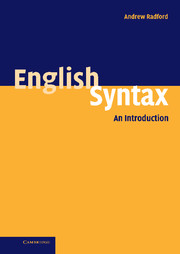1 - Grammar
Published online by Cambridge University Press: 05 June 2012
Summary
Overview
In broad terms, this book is concerned with aspects of grammar. Grammar is traditionally subdivided into two different but inter-related areas of study – morphology and syntax. Morphology is the study of how words are formed out of smaller units (called morphemes), and so addresses questions such as ‘What are the component morphemes of a word like antidisestablishmentarianism, and what is the nature of the morphological operations by which they are combined together to form the overall word?’ Syntax is the study of the way in which phrases and sentences are structured out of words, and so addresses questions like ‘What is the structure of a sentence like What's the president doing? and what is the nature of the grammatical operations by which its component words are combined together to form the overall sentence structure?’ In this chapter, we take a look at the approach to syntax adopted by Chomsky.
Universal Grammar
Within traditional grammar, the syntax of a language is described in terms of a taxonomy (i.e. classificatory list) of the range of different types of syntactic structures found in the language. The central assumption underpinning syntactic analysis in traditional grammar is that phrases and sentences are built up of a series of constituents (i.e. syntactic units), each of which belongs to a specific grammatical category and serves a specific grammatical function.
- Type
- Chapter
- Information
- English SyntaxAn Introduction, pp. 1 - 27Publisher: Cambridge University PressPrint publication year: 2004
- 1
- Cited by



